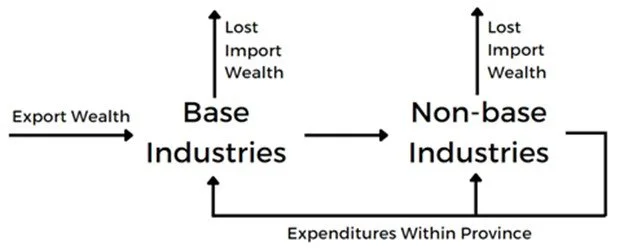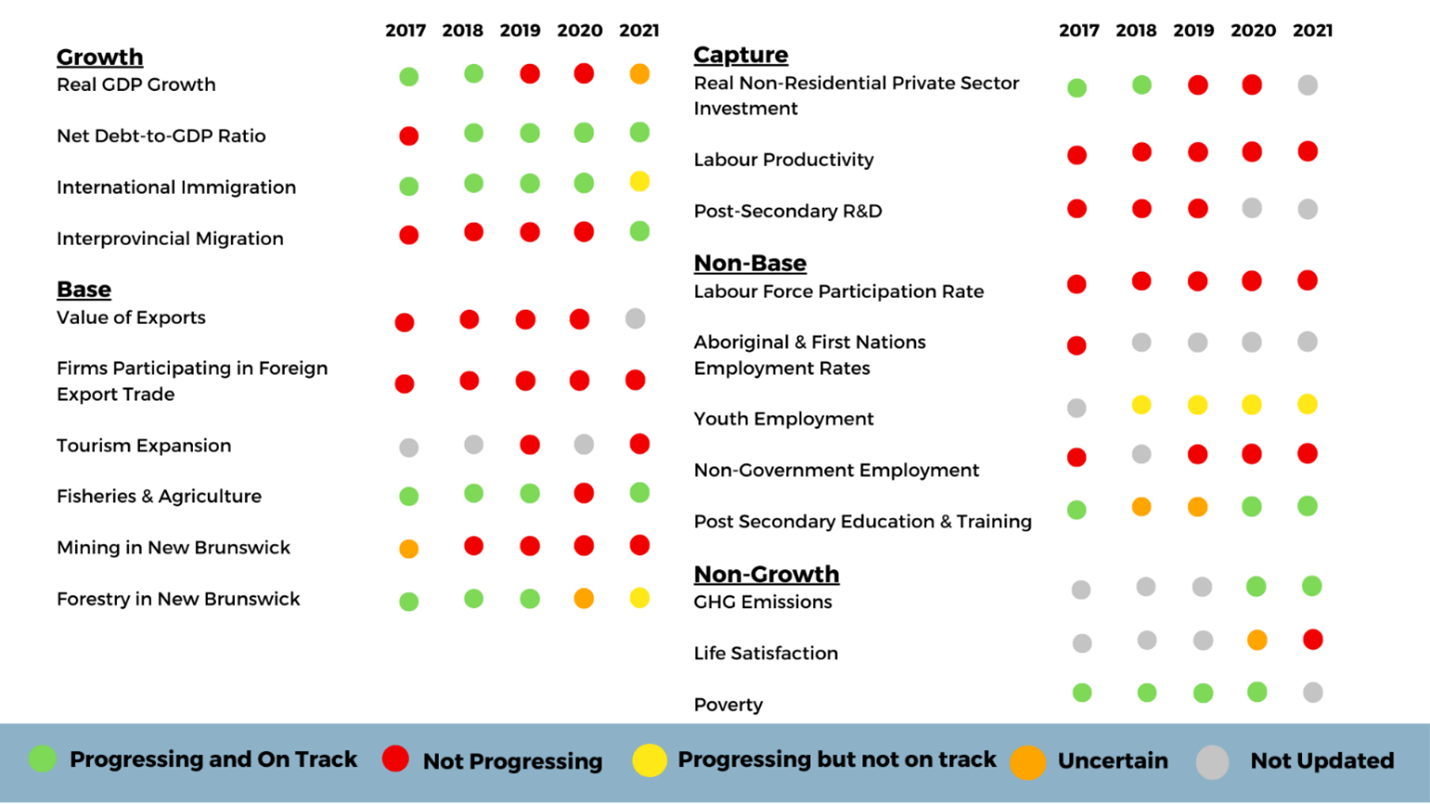Recent Articles
Categories
Have you ever wondered what factors influence your daily life? That is, your income or the cost of your house, the healthcare system, or even your well-being? Or how your life in New Brunswick compares to the rest of Canada? These factors are represented in many ways, starting at the beginning of one’s life. Following birth, data is collected from almost every government interaction an individual has. This data is used to gain insight into what processes need to change and what types of decisions benefit citizens. From a purely observational perspective, two student research groups analyzed such open-source data to identify critical discrepancies between geographical locations within the province and the progress on set economic goals.
This year, the New Brunswick Institute for Research, Data and Training (NB-IRDT) brought together two student research streams to explore factors influencing New Brunswickers’ daily lives: BoostNB and PopulationNB (PopNB). BoostNB and PopNB are part of the Pathways to Professions (P2P) experiential learning program run by NB-IRDT in a pilot partnership with Future GNB. The BoostNB and PopNB teams assess the economy and well-being of New Brunswick annually through varying lenses and research topics. When researching the economic and demographic factors of the province, both teams discovered significant influences – positive and negative – that impact the lives of New Brunswick residents. Together, they described how these factors have manifested within the province and what can be done to improve the lives of their fellow New Brunswickers.
Introducing BoostNB
In 2022, BoostNB was comprised of five university students: mentor Caroline Pietroski, communications coordinator Sudhish Poojary, and student researchers Jakob Ashfield, Joseph Drost, and Tianjiao Yang. This summer, the team focused on developing and updating an online dashboard on economic indicators that provides straightforward, fact-based information about the New Brunswick economy. With the goal of having better informed New Brunswickers, the BoostNB team has identified economic sectors and their accompanying “stretch goals,” which have been created and identified in response to the OneNS Now or Never Action Plan. Using data from Statistics Canada, the BoostNB team annually identifies emerging economic trends and developments within the province of New Brunswick.
Introducing PopNB
The 2022 PopNB research team was also comprised of five students: mentor Lee Whelan, student researchers Courtney Stacey, Evan Smith, and Hannah Breneol, and communications coordinator Paige Stewardson. The PopNB research stream assesses the demographics and characteristics of the province through research on population growth, immigration and migration, employment vacancies, income and poverty, housing affordability, transportation, and access to healthcare. This year, the PopNB team expanded its scope to compare urban and rural regions of the province. By doing so, the team could assess whether there were discrepancies between the urban and rural regions in these seven research areas. Through various deliverables, such as an infographic and final report, the PopNB team detailed significant findings to community members and stakeholders to support evidence-based policymaking in the province.
Here’s a snapshot of what both teams found:
BoostNB: Sharing Fact-Based Information on the Province’s Economic Goals
BoostNB started its summer by delving into the most recent open-source data to begin updating last year’s economic measures. This investigation allowed the students to update reports and ultimately “stretch goals.” Stretch goals, essentially, are deliberately ambitious objectives to boost New Brunswick’s economic progression. For example, one of the stretch goals that BoostNB researched related to the province’s real GDP (gross domestic product) growth, and the goal BoostNB established was that “By 2028, New Brunswick seeks to experience an upward trend that returns its GDP growth rate to 2008 levels.” To justify the reasoning and purpose of these stretch goals, the team codified the stretch goals into a regional growth model, initially developed by Allan Pred (1966), as pictured below in Figure 1.
Figure 1: Visual Representation of the Regional Growth Model
As pictured above in Figure 1, money or wealth only enters the cycle through exports and only leaves through import leakages. Import leakages refer to wealth that leaves the province due to importing goods and services. With this model in mind, two ways to grow the economy would be to increase exports relative to imports or increase the retention of export wealth within the province.
BoostNB used this model to show how each goal contributes to the economy’s well-being. Most of the wealth creation in the province results from exporting industries, primarily manufacturing and natural resources. Capture goals improve the competitiveness of New Brunswick’s outward-facing industries, while non-base goals represent how well this wealth is working its way through the economy via employment. Non-base goals are essential for maintaining a sustainable labour force. By showing the bigger picture and how the goals fit together, BoostNB communicates a more holistic understanding of economic factors in New Brunswick.
New Brunswick’s Economic Report Card
Each of BoostNB’s 21 stretch goals fits into this model and plays a role in the direction of the province’s economic success. The status of all the stretch goals is shown in the visual below. Each goal has been placed in the appropriate grouping and provided with a colour to reflect its status. The status is significant and has been determined based on the following parameters:
Progressing and On Track – If a goal displayed growth in the last five years in most of the relevant indicators, and if this growth clearly indicates that the goal could be achieved soon, that goal was determined to be progressing and on track.
Not Progressing – If a goal displayed a decline in the last five years and showed no sign of growth, that goal was labelled as not progressing.
Progressing and Not On Track – If a goal displayed growth in the last five years in most of the relevant indicators, and if this growth did not clearly indicate that the goal could be achieved soon, then it was determined to be progressing and not on track.
Uncertain – If a goal displayed multiple fluctuations and did not indicate growth or decline, that goal was considered uncertain.
Not Updated – If the team did not have access to the latest data for a particular goal, then that goal was labelled as not updated.
Figure 2: Report Card of All Stretch Goals
Note: The year corresponds to the year for which data was available, not the year reports were updated.
The main takeaways from this report card are as follows:
New Brunswick is not progressing toward many goals that would ensure economic growth. Many growth-related goals (including the Growth, Base, Capture, and Non-Base groupings) are not progressing, and 9 out of 18 goals do not show progress in the most recent data.
New Brunswick is progressing towards most of its non-growth goals, which are goals related to the social and environmental welfare of New Brunswick residents.
The implications of these findings are discussed further below. The BoostNB team feels this fact-based information needs to be shared widely to inform New Brunswickers better. This information is crucial not only for New Brunswickers’ wallets but also for their overall well-being. With this new data, the team made it their mission to make their findings more accessible by creating their new interactive website (boostnb.com) from scratch. Additionally, further information is available through BoostNB’s four new social media accounts (LinkedIn, Twitter, Instagram, and Facebook), which will be used to distribute all the detailed information regarding each goal weekly.
PopNB: Characterizing Urban-Rural Differences in Quality of Life
New Brunswick is a unique province with its population almost divided equally among urban and rural areas (51.17% Urban: 48.82% Rural). With younger people finding excitement and opportunities in urban areas, older ones are finding serenity in rural areas. The near-equal population divide in New Brunswick is important to explore, given the impacts on the distribution of resources. Despite the population distribution, rural areas often lack the same resources as urban communities, potentially impacting the well-being of residents in rural communities.
Immigration and Mobility
Deaths in the province, no matter the region, significantly outnumber births. The result of a high death rate indicates New Brunswick is heavily relying on newcomers to ensure population growth. Therefore, population growth cannot be discussed without addressing international migration. The province has struggled to bring immigrants into rural areas and retain them. Despite the struggle in rural areas, urban parts of the province have seen immense success in growing their population through immigration.
Job Vacancies
Although New Brunswick’s population is on the rise, job vacancies in the province are also climbing and increasing in all regions of the province between 2017 and 2021. This increase was particularly significant in the Campbellton/Miramichi area, where – although they saw a reduction in job growth of almost 5% – residents also saw the highest change in job vacancies, increasing by nearly 4%. High unemployment rates also exist in New Brunswick, emerging disproportionately in rural areas. Furthermore, employment insurance beneficiaries were shown to be three times higher outside of urban centres.
Income and Poverty
New Brunswick’s urban and rural inequities regarding earning and spending money are apparent. A person living in a rural area can expect to make less than the median New Brunswick income. In contrast, all three metropolitan areas (Fredericton, Moncton, and Saint John) have median incomes over the provincial median. Although a person can expect to make more in New Brunswick’s urban areas, individuals can also expect to spend less. Two of the three urban cities in the province (Moncton and Saint John) have lower spending amounts per family than all rural areas in New Brunswick.
Housing
Essential to the conversation on income and poverty is housing affordability and availability in the province – another topic PopNB explored this summer. Research on housing affordability within New Brunswick’s urban and rural areas showed one of the largest discrepancies was the number of citizens in core housing needs. Specifically, in rural areas, although having nearly the same population as urban communities, individuals do not have the same access to resources. This inequity leaves rural citizens more likely to own a property that costs more than 30% of their before-tax household income.
Transportation
Speaking of access to resources, most of the public transportation offered in New Brunswick is confined to the three urban areas. While some larger rural communities, such as Miramichi and Bathurst, are expanding their public transit, and volunteer ride services are popping up around the province, rural individuals depend on personal modes of transportation. This transportation is typically confined to a vehicle, whether on their own or hitching a ride with friends or family.
Access to Healthcare
In New Brunswick, 65% of people live with at least one chronic health condition, with a third of those living with three or more chronic conditions. This statistic is much higher than the national average of 44% living with at least one chronic health condition. Apart from Miramichi (Zone 7), populations in all health zones currently sit between 62% and 68%, consistent with the provincial average of 65%. Although there does not seem to be a discrepancy between urban and rural residents regarding chronic illnesses, large hospital facilities are concentrated along the southern portion of the province within the urban centres. With the lack of public transit in rural areas and a nearly even spread of chronic conditions across the province, the concentration of hospitals within the urban centres is inaccessible due to a large percentage of the population requiring these services.
Conclusion
Each year the BoostNB team focuses on researching the well-being and economic performance of New Brunswick. However, this year, the team expanded their research and developed a communication plan to make their findings more accessible to the average New Brunswicker so residents can make well-informed economic decisions. BoostNB’s research found that New Brunswick is not progressing toward most of the identified economic stretch goals. The focus on improving these economic areas would ensure growth and overall greater success for the province moving forward. However, New Brunswick is meeting and exceeding the stretch goals based on social and environmental welfare, which indicates that New Brunswick may be going in a direction that is more focused on the intangible welfare of its residents rather than the direction of provincial economic growth.
Meanwhile, the PopNB team heavily focused on New Brunswick residents by concentrating on research topics that impact their daily lives. This year, their research went one step further by assessing discrepancies between urban and rural regions. Results indicated that rural communities often lack the same resources as urban communities, leading to large discrepancies between the two areas. For instance, there are significant differences between urban and rural realities regarding the cost of living, annual income, and population growth. Residents also have differences in healthcare access, even though in each region, they are likely to have similar experiences with prevalence of chronic conditions. These discrepancies led PopNB to propose policy implications on public transportation, housing affordability, and income and poverty to improve the lives and well-being of New Brunswick residents, such as expanding public transit to rural areas. Hence, residents have better access to necessary resources, like healthcare centers.
Together, the BoostNB and PopNB research teams worked toward monitoring factors that impact the well-being of New Brunswickers and investigating the reasons behind disparities within the province. With these latest findings accessible to the public, residents can stay informed on factors influencing their daily lives, helping them make decisions that promote positive change. Through this research, decision-makers have access to evidence-based information relevant to their constituents and potential avenues to create positive change throughout the province. Both research teams’ findings prove that, although small, New Brunswick is a mighty province that has yet to reach its full potential but is quickly striving toward achieving it.
Authors
Article Licensing Information
 The text of this article is licensed under a Creative Commons Attribution-NonCommercial-NoDerivatives 4.0 International License. Any other media accompanying the text of the article is not included in the license. Accompanying media will have additional licensing information and if no accompanying license is present, is it assumed to be all rights reserved.
The text of this article is licensed under a Creative Commons Attribution-NonCommercial-NoDerivatives 4.0 International License. Any other media accompanying the text of the article is not included in the license. Accompanying media will have additional licensing information and if no accompanying license is present, is it assumed to be all rights reserved.










